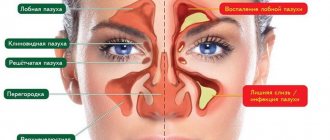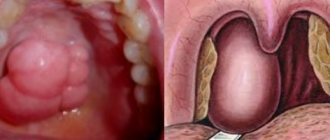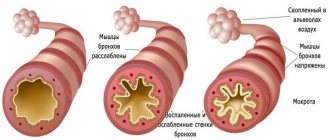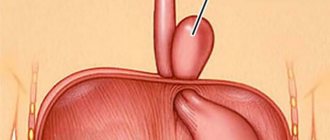What is a cyst and types of classifications
Discomfort in the throat may indicate the presence of an illness
When describing a cyst, it can be characterized as a pathological cavity that has its own walls and internal contents (usually filled with a substance of liquid or semi-liquid consistency). Externally, it is round or bag-shaped with a smooth surface, and can be yellowish or pink in color. Neoplasms grow to different sizes from a couple of millimeters or more (up to spreading over the entire area of the epiglottis).
Cysts in the larynx differ in location, based on this they are divided into:
- laryngeal;
- supraglottic;
- palatal;
- formed at the base of the tongue;
- almond
Attention! About 80% of cysts form on the left side of the larynx.
Classification is also provided by origin, thus, cystic neoplasms are:
| Congenital | As the name suggests - obtained at birth as a result of disturbances during the embryonic development of the fetus, these include, for example, a median laryngeal cyst |
| Secondary | Formations that are the result of degeneration of other tumors in the throat, for example, fibroids |
| Dermoid | They are formed when there is a blockage in the laryngeal gland of the excretory duct; their structure is distinguished by thick, mushy contents |
| Retention | They are formed in the same way as dermoid ones, but have thinner walls and liquid, sticky contents. This type of formation is the most common |
| Laryngocele | This special species has air inside the new growth. The second name is laryngeal air cyst |
Benign neoplasms (cysts are one of them) are safe, they do not lead to death, do not metastasize and do not disrupt the functioning of other organs, unlike malignant ones. However, many of them can disrupt the patient’s quality of life by their appearance and symptoms that manifest themselves during growth. Large cystic neoplasms can block the lumen of the pharynx, this causes a constant lack of oxygen, and over time leads to suffocation.
Carefully! Any benign tumors are accompanied by a risk of cell malignancy (malignancy), and therefore require constant monitoring by an ENT doctor.
Possible complications
Such cysts are dangerous because they can cause a large number of complications. One of the most dangerous is cyst suppuration. At the same time, the body temperature rises, and symptoms of intoxication are observed. The condition is accompanied by weakness and sore throat. In order to avoid this, patients can be prescribed antibiotics.
One of the most severe possible complications is the growth of the cyst to a size where it blocks the entrance to the throat and interferes with the access of oxygen. This is especially dangerous in the case of young children. It is rare for a cyst to transform into a cancerous tumor. Therefore, consultation with a doctor is mandatory.
There are no specific methods of prevention. But it has been proven that they occur less frequently in people who suffer less from bad habits and lead a healthy lifestyle. People who have small children need to be especially careful, because due to their body characteristics, such a cyst can lead to serious consequences.
Postnasal drip syndrome - signs of the disease, treatment and prevention
Causes of neoplasms and risk groups
For most types, doctors have not yet come up with an unambiguous conclusion about what leads to the development of cysts in the larynx. Retention and dermoid appear due to blockage of the laryngeal gland with mucus and microscopic debris, and the excretory duct can also block the resulting scar.
Consultation with an Israeli oncologist
This type of benign tumor can form at any age: in both children and adults. In babies, it is congenital and is a consequence of disturbances during the embryonic development of the fetus. There may be a connection with genetic predisposition.
In adults, those at risk of developing a benign tumor in the throat include:
- heavy smokers (cigarette smoke is a powerful irritant);
- people who abuse alcohol;
- persons living in polluted, environmentally unfavorable areas;
- those who work in hazardous working conditions (the presence of asbestos dust and coal particles in the inhaled air also leads to blockage of the duct);
- people with a family history.
The cause of the pathological process may even be simply poor oral hygiene.
Carefully! For men, especially young and middle-aged men, pathological formation is more common than for women.
Causes
The exact etiological agent is still unknown to medicine. The causes of cysts in the throat are based on physiological irritation of the receptors of the mucous membrane:
- genetic conditioning – the risk of development increases significantly;
- active and passive smoking - inhaled smoke is a strong irritant, it carries a toxic load on the mucous membrane of the throat, which increases the risk of tumor development;
- alcohol in large quantities - alcohol has a similar irritation to the receptors of the laryngeal mucosa, which provokes a violation of tissue regeneration;
- professional features - inhalation of dust particles, heavy metals in large quantities plays the same role as cigarette smoke;
- insufficient oral hygiene – active proliferation of bacterial flora leads to frequent sore throats, which is a direct factor in the development of pathology.
It has been established that benign tumors of the larynx develop more often in men. This is due to genetic characteristics and the fact that men are more often susceptible to the influence of the above bad habits.
Methods for diagnosing pathology
In cases where the cystic tumor is small in size, does not cause discomfort and is not accompanied by symptoms, it is discovered by chance by an otolaryngologist or dentist during a routine examination.
It is difficult to identify small cysts on your own, because in appearance they are almost invisible against the background of the laryngeal mucosa due to their natural pink color. An increase in the size of the tumor most often leads to a change in the shade of the shell to yellow, in addition, blood vessels often appear on their surface. This pathological formation grows very slowly, but over time its walls become thinner and it will become similar to a painless blister (for a more visual representation, you can look at the photos of laryngeal cysts posted in considerable quantities on the Internet resource).
Various research methods are used to detect pathology
Initially, pharyngoscopy is sufficient to identify a tumor, but this is not enough for a final diagnosis. It is very important to confirm the absence of malignancy in the tumor; for this, the patient is prescribed:
Treatment
Treatment of cysts in the larynx is carried out using conservative methods and surgery. The first ones are used in cases where the tumor reaches a small size. With the help of conservative therapy, it is possible to stop the growth of the tumor and reduce the likelihood of infection of local tissues.
In the local treatment of neoplasms the following are used:
- "Furacilin";
- "Iodinol";
- "Chlorhexidine";
- "Lugol";
- "Chlorophyllipt" and other antibacterial drugs.
To reduce the size of the cystic cavity, glucocorticoids are prescribed. It is recommended to combine these drugs with vitamin complexes or lymphotropic substances (Lymphomyosot, Tonziotren). The latter increase local immunity, stopping the negative effects of glucocorticoids.
To strengthen the body's defense mechanisms, immunomodulators are indicated. Drugs in this group (Echinacea tincture, Ribavirin, Betaferon) slow down the destructive processes occurring in the tissues of the larynx.
For large tumors in the throat, surgical intervention is recommended. Depending on the indications and individual characteristics of the patient, the following are used:
- puncture;
- endolaryngeal and endopharyngeal removal;
- open surgery;
- laser removal.
Treatment options for benign neoplasms
For the treatment of laryngeal cysts, surgical intervention is provided; there are several practiced methods of operation; the choice of the optimal option is carried out individually.
- Puncture (puncture) of the neoplasm. A simple procedure that is based on pumping out the contents of the tumor using a syringe through a puncture in its wall. The only negative is that the walls of the pathological formation remain in the larynx, and this increases the risk of relapse.
- Endolaryngeal "biting". The procedure is based on cutting off the top of the cystic formation, while part of the wall and contents are removed, and the tumor itself turns from an inflated ball into an open fossa. This method is the most common today; it is chosen in cases where there is no need to completely remove the cyst.
- External removal. It is used for complicated or large tumors. For this operation, an incision is made in the neck through which removal is performed.
In the postoperative period, it is necessary to treat the throat with medications based on natural antiseptics, and effective rinsing with Tonzinal, Povidone-iodine or others. Vitamins and medications that stimulate the immune system must be prescribed. Rinsing with a decoction of chamomile and sage may be added. It is especially important to prevent the development of purulent inflammation.
After any of the operations described, patients require a two-week period of recovery and rehabilitation aimed at reducing the risk of relapse, which includes:
- strict gentle diet. With it, you should avoid eating foods that irritate the throat mucosa (spicy, salty, excessively sour, and also too hot or cold);
- complete cessation of alcohol and smoking;
- rest and proper sleep;
- It is especially recommended to be in an environmentally friendly area.
Diagnostic methods
Timely diagnosis of the disease increases the chances of a full recovery. Therefore, if unpleasant symptoms appear, you should immediately consult a doctor.
The diagnosis is determined using the following instrumental diagnostic methods:
- Needle biopsy. — Reveals the contents of the cyst, its type, and also confirms the benign nature of the compaction.
- MRI, CT. — Determine size and location with maximum accuracy.
- Radiography. — Pictures are obtained in different projections with a clear determination of the size of the tumor.
- Ultrasound. — The structure of the neck is most clearly visible through ultrasound signals. — Easily determines the contents of a cystic formation.
In addition to the main diagnostic methods, additional ones are used. They are used to check the entire throat area, including the ear canals and sinuses.
The doctor performs:
- Otoscopy. Used for ear diagnostics.
- Rhinoscopy. Instrumental examination of the nasal passages.
If persistent hoarseness is observed, stroboscopy is performed. The method is based on studying the vocal cords using light pulses.
Features of treatment for individual patients
Surgical interventions for cysts only according to the decision of the attending physician
Very small tumors may not require removal, but must be monitored by an otolaryngologist. If they grow, surgery will be recommended. At the same time, there are many cases where patients with small cysts in the larynx lived their entire lives without encountering complications.
If a cystic tumor is found in a newborn, then it requires urgent surgical intervention, since even its very small size will block the already narrow passage of the larynx, which poses a serious danger to the baby.
Surgical removal of the tumor is not recommended during pregnancy and lactation; it can only be prescribed in critical cases.
Treatment of a cyst in the throat
Symptoms and treatment are directly dependent on the size of the tumor. Therefore, a thorough diagnosis sets the framework for therapy.
A throat cyst can be treated conservatively and surgically. If the neoplasm is detected by chance and does not provoke any symptoms, then conservative treatment is prescribed. However, constant monitoring is required. If the tumor continues to grow and is a source of proliferation of bacterial flora, surgical methods are used.
Conservative therapy
Drug treatment cannot rid the patient of a throat cyst once and for all. Therapy can only stop its growth and reduce the risk of infection of the tumor. In other words, drug treatment improves the sanitation of the oral cavity, thereby reducing the risk of developing inflammatory diseases of the upper respiratory tract. Local and systemic antibacterial drugs will help with this:
- gargling with a solution of Furacilin, Hepilor, Chlorhexidine, Iodinol;
- irrigation of the mucous membrane with a spray or solution of Lugol, Tonginal, Chlorophyllipt.
Diagnostics
Due to the asymptomatic course of the disease, it is detected in the early stages by chance.
For this purpose, an x-ray is performed. In the resulting image, the doctor will be able to see that the cyst in the mouth has already formed. In addition, in the presence of a large number of symptoms, an experienced doctor is able to identify oral pathology even at the initial stages of its development:
- A feeling of heaviness localized in the root region;
- Problems with motor function of the jaw;
- While eating, a feeling of discomfort appears in the gum area;
- Transition of aching pain into continuous malaise;
- Development of a small bubble localized in the root zone;
- The appearance of severe fatigue, a sudden increase in temperature, without obvious reasons;
- Development of a fistula.
Diagnosis of the disease
At the initial stage of development of the disease there are no symptoms. It may be accidentally discovered by an ENT doctor during an examination or identified by a dentist. If discomfort occurs, you should consult an otolaryngologist. The procedure of pharyngoscopy or fibrolaryngoscopy will help determine the cause of the tumor. Patients are required to undergo:
- X-ray;
- examination of the nasal cavity;
- MRI or CT;
- examination of the tissue of the affected area;
- ear examination.
Even if the pathology is not serious, you need to consult several specialists at once. This will help you learn as much as possible about the disease. Be sure to make an appointment with a neurologist and have your vision checked. It would not be superfluous to consult an oncologist and, if necessary, undergo tests.
Description and causes of the disease
The cyst has a round shape. A neoplasm with thin walls is usually filled with fluid inside. The surface of the cyst is smooth, and the boundaries are clearly visible. The neoplasm can be acquired or congenital in origin.
Most often diagnosed in representatives of the stronger sex who have crossed the mark of middle age. Location: near the sky and tonsils. At the same time, the person does not complain of breathing problems. If the tumor grows, it may interfere with the functionality of the epiglottis.
There are several reasons that contribute to the appearance of a cyst. However, they were never confirmed. If a neoplasm appears in children, it is congenital. This phenomenon is caused by pathological changes during fetal development.
Education looks like a bubble. The tumor also appears after an adenoma or fibroma. Symptoms of a benign neoplasm appear as a result of exposure to certain factors. Among them are heredity, poor oral hygiene, harmful working conditions, smoking, and alcohol abuse.
Symptoms of pathology
The tumor-like neoplasm develops unnoticed. At the initial stages of growth, it cannot be distinguished from healthy tissue. Moreover, the color remains the same. Besides this, there is no pain.
After 1-2 weeks, the first symptoms begin to appear. Signs of the disease become noticeable due to the increased size of the tumor. The following clinical picture is distinguished:
- inability to breathe fully;
- lack of feeling of lightness after swallowing;
- lump on the neck;
- change in tone of voice;
- cough that does not provide relief;
- hoarse and slurred speech.
There is no pain when pressing on the swelling. Due to its small size, the tumor disappears for a while, as it dissolves under finger pressure. Enlargement of the cyst leads to difficulty swallowing, and respiratory function is impaired. Due to the rapid progression of the disease, a person may lose the ability to speak.
As a result of a visual examination, a tumor is noted that is soft to the touch and does not cause pain. As the tumor grows, the color also changes. The tumor tissues acquire a reddish or yellowish tint. There are no more changes.
Symptoms change if adequate treatment is not provided. When tissues suppurate, toxins are released into the patient's body. Substances are carried throughout the body through the bloodstream. The patient's temperature rises, chills and body aches are felt, the person suffers from insomnia, eats poorly or completely refuses food. If the tumor increases in size, breathing and movement of food becomes difficult.
Asphyxia is a severe case that occurs as a result of complete suffocation.










